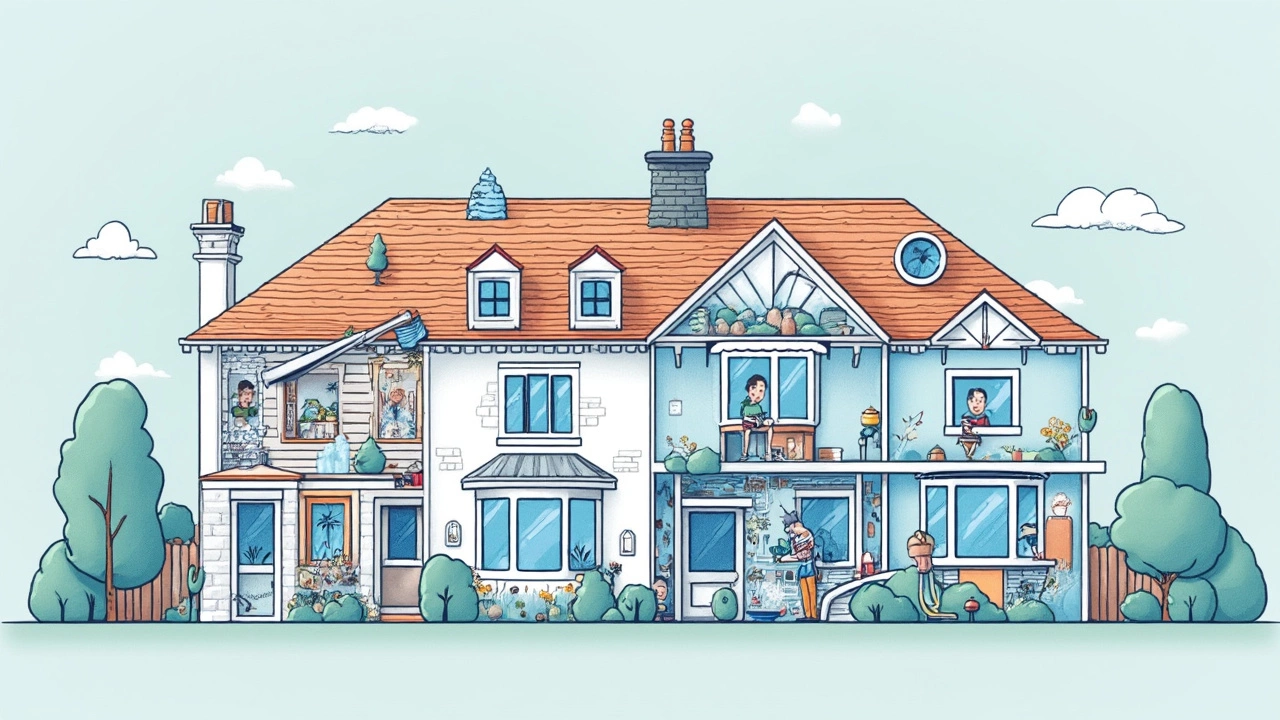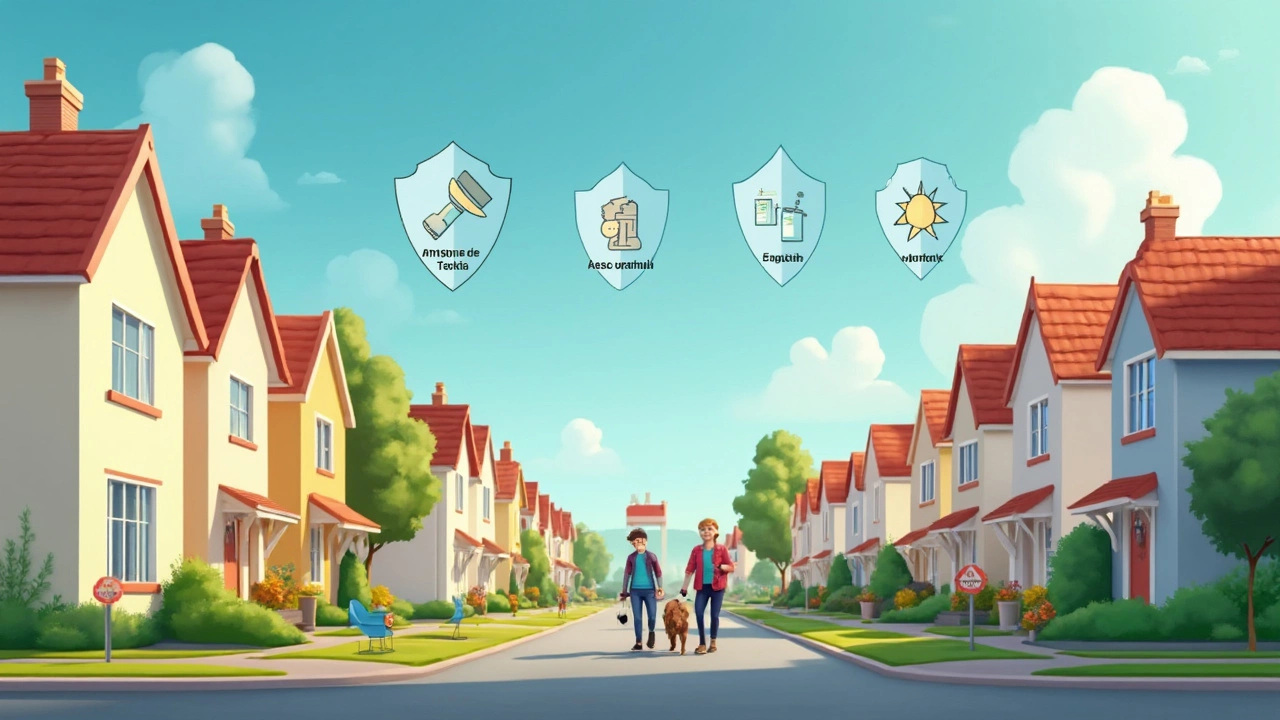If you’ve ever tried to read through a homeowners insurance policy, you know it can feel like trying to understand another language. It’s full of terms and limits you didn’t know you needed to care about, until you suddenly do. Here’s the heart of it: every homeowners policy has four main coverages. These aren’t just ‘nice extras’—they’re what keep your financial life breathing easy when stuff happens.
Let’s get straight to it. The first two cover the physical parts: your house itself and the buildings around it (think garage, fence, that tired shed in the back you keep meaning to fix). The next two? They focus on your belongings and those awkward moments when someone gets hurt at your place. If you’re ever not sure what’s covered, or you’re worried you might not have enough, you’re already smarter than most. Real protection starts with actually knowing what your policy promises.
- Dwelling Coverage: Protecting Your Home’s Structure
- Other Structures: Sheds, Garages, and Fences Count Too
- Personal Property Coverage: What’s Inside Matters
- Liability Protection: Coverage for the Unexpected
- Tips for Getting the Right Coverage
Dwelling Coverage: Protecting Your Home’s Structure
If there’s one thing you don’t want to risk, it’s the actual bones of your house. Dwelling coverage is the part of your homeowners insurance that pays to repair or rebuild if your home is damaged by things like fire, windstorms, hail, lightning, or even something really unlucky—like an out-of-control car crashing through your living room. This coverage is what lets you sleep better during crazy storms and after your kids leave the oven on a little too long.
Dwelling coverage doesn’t just stop at the four outer walls. It includes the roof, attached garage, foundations, floors, walls, and often things like built-in appliances and plumbing inside the walls. Basically, if it’s stuck to your home and you can’t just pick it up and walk away with it, dwelling coverage probably has your back.
Want a real number? According to the Insurance Information Institute, over 97% of homeowners insurance claims for property damage in the past decade were related to dwelling coverage—things like wind or fire that wrecked part or all of the home.
To figure out how much coverage you need, don’t just look at the recent property sale prices. You want enough to actually rebuild your house from the ground up, not just pay off your mortgage. That number is called the “replacement cost.” It’s almost always different (and usually higher!) than your home's market value because you have to think about construction costs, materials, and even contractor fees, not what your neighbor got on their last sale.
- Make sure your policy covers replacement cost, not just cash value. Actual cash value subtracts for depreciation, which can leave huge gaps if your house is older.
- Some policies come with “extended replacement” or “guaranteed replacement” cost. If you’re in an area with sudden labor shortages or crazy prices after disasters, this can mean the difference between a rebuild and a frantic GoFundMe page.
- Many policies don’t cover flooding or earthquakes. You’ll usually need separate coverage for those. Don’t assume you’re covered just because you have a regularhome insurance policy.
Double-check your limits every couple of years. Costs go up, and that basic policy from a decade ago might not even be close anymore. If you’ve done a big renovation or added an extension (or even finished your basement), update your policy before trouble hits. Trust me, nothing’s more annoying than learning you were underinsured when it’s time to fix a hole in your roof.
Other Structures: Sheds, Garages, and Fences Count Too
When people think about homeowners insurance, they usually picture coverage for the main house. But your policy swings a little wider than that. "Other Structures" coverage is the part that steps up for things like detached garages, garden sheds, backyard fences, and even driveways. Basically, if it’s a structure on your property but not physically connected to your house, this is the coverage that applies. Crazy, but even a fancy mailbox could count if it’s on your land and costs a bit to replace.
Most home insurance policy setups include this by default. The standard rule is your other structures get about 10% of what you have on your main dwelling coverage. So if your house coverage is $300,000, your sheds, fences, and little backyard studio usually get $30,000. Not a penny comes out of your main coverage for these extras—they’re separate buckets.
| Structure | Covered? | Notes |
|---|---|---|
| Detached Garage | Yes | Must not be attached to main home |
| Garden Shed | Yes | Even tiny prefab sheds count |
| Fence | Yes | Includes wooden, metal, or vinyl fences |
| Gazebo | Yes | Covers storm or fire damage |
| Pool (above-ground) | Sometimes | Check with your insurer, rules can vary |
What kinds of disasters does this part help with? Fire, certain storms, vandalism, and even vehicles crashing into your fence are typically covered. Floods and earthquakes, though, that’s a different story—standard policies won’t cover those unless you get separate add-ons.
- If you put a lot of money into a deluxe workshop or fancy greenhouse, check if that standard 10% number is really enough. You can bump up that limit if you need to, but you have to tell your insurer ahead of time.
- Renting out your garage as a side hustle? Or using a shed for business stuff? Your normal "other structures" coverage probably won’t help if there’s a claim. That needs extra business coverage.
- Always keep track of updates or replacements—new fences and sheds aren’t automatically on your policy. Let your insurer know about anything major you add.

Personal Property Coverage: What’s Inside Matters
This is the part of your homeowners insurance that protects your stuff. If your belongings get destroyed or stolen due to things like fire, theft, or tornadoes, this coverage helps you replace them. People often forget just how much all their stuff is worth until a disaster hits. Imagine replacing every shirt, plate, and tablet in your house—those numbers add up fast.
Personal property coverage usually equals about 50% to 70% of your dwelling coverage, so if your main house is insured for $400,000, you’ll often see $200,000 to $280,000 in coverage for your things. But here’s the tricky part: there are usually set limits for certain items—like jewelry, art, cameras, or even those high-end headphones your teen begged for (mine, Thalia, included). If you have valuables, you’ll want to check your policy or think about scheduled personal property coverage—that’s just a fancy term for extra insurance on the stuff you really care about.
Here’s what’s usually covered:
- Clothes, shoes, and accessories
- Electronics, like TVs and laptops
- Appliances that aren’t built in
- Furniture—beds, couches, tables
- Sports equipment and bikes
- Toys and hobby gear
Don’t forget: your stuff is covered even when it’s away from home. So if your laptop gets swiped from a cafe or your kid’s bike is stolen from school, you can file a claim. Most companies set a lower amount for things lost or stolen off property, though, so double-check how much they’ll pay in those situations.
| Item | Sub-limit (Per Claim) |
|---|---|
| Jewelry | $1,500 |
| Silverware | $2,500 |
| Firearms | $2,500 |
Quick tip: Do a home inventory. Grab your phone, walk room by room, and record what you own. Snap pics, save receipts, and jot down big-ticket items. It might sound tedious, but you’ll thank yourself if you ever need to make a claim. And remember, if you’ve got extra-expensive gear, talk to your agent about more coverage before trouble finds you.
Liability Protection: Coverage for the Unexpected
This is the part of your homeowners insurance that comes up when life gets a little wild—like your dog bites a neighbor, or a friend trips on your broken step and ends up in the ER. Liability protection pays for injuries and damage that you’re legally responsible for, even if they happen away from your actual house.
What gets covered? Stuff like medical bills for injuries that happen on your property. It also covers legal costs if someone decides to sue you after slipping on your icy sidewalk. That’s huge—a single lawsuit can easily run into tens of thousands, sometimes more. Some policies even pitch in for property damage if you or a family member wreck something by accident that belongs to someone else (for example, your kid throws a baseball through a neighbor’s window).
- Pays for medical costs when someone gets hurt on your property
- Covers legal defense and settlements if you’re sued
- Takes care of property damage you or family members cause elsewhere
- Usually includes “no-fault” medical coverage, so guests’ minor injuries get covered quickly, avoiding drama
How much coverage? Most basic policies hand you at least $100,000 in liability protection, but experts say $300,000 or more is smarter (especially if you have a trampoline, a pool, or kids who love to invite a football team over). The extra coverage rarely hikes your premium by much, and it keeps your savings and house safe if a worst-case scenario hits. My dad’s neighbor once faced a $200,000 claim over a single accident at a birthday party—a $20 bump in his policy made all the difference.
You can also snag something called an “umbrella policy.” It adds even more liability protection on top, so you never lose sleep about gaps. It kicks in when your regular home insurance liability reaches its limit. Some folks grab this after seeing lawsuits skyrocket; it’s extra peace of mind for a surprisingly low cost.
| Liability Limit | Average Annual Premium Increase* |
|---|---|
| $100,000 | $0 |
| $300,000 | $10-$20 |
| $500,000 | $30-$50 |
*Estimates based on national data for 2024–2025
Tip: Check if your policy excludes certain incidents—like some dog breeds, business activities, or dangerous backyard attractions. Ask questions before you need the coverage. The last thing you want is to get surprised after the fact.

Tips for Getting the Right Coverage
Getting homeowners insurance right isn’t just about picking a policy and moving on. You’ve got to make sure the coverages actually fit your life. I learned this the hard way when a pipe burst in our laundry room, and trust me, the wrong coverage would’ve turned a soggy day into a total disaster.
- Don’t lowball your home's value. Go room by room and actually add up what it would cost to rebuild with today’s materials and labor. The average rebuilding cost has jumped almost 30% in the last five years, mostly thanks to labor shortages and material prices going through the roof.
- Check your limits for personal property. Most policies cover about 50%-70% of your dwelling coverage for personal property, but if you've upgraded your kitchen appliances or have home tech up the wazoo, bump that number up. Take photos or, even better, do a quick video tour with your phone for proof.
- Don't forget special stuff. If you have jewelry, sports gear, collectibles, or high-end bikes, ask about riders or endorsements. Regular homeowners insurance usually has very low limits (think $1,500 for jewelry!).
- Update for life changes. Finish a basement? Add a deck? Welcome a new pet (especially one with teeth)? Tell your insurance agent. Small changes can make a big difference if you ever have a claim.
- Ask about discounts. Installing smoke detectors, security systems, or smart leak sensors can lower your premium. Some companies even knock off 10%-20% for bundling your home and auto insurance.
| Coverage Type | Avg. Limit | Avg. Annual Premium |
|---|---|---|
| Dwelling Coverage | $300,000 | $1,430 |
| Personal Property | $150,000 | Included |
| Liability | $300,000 | Included |
If you’ve got questions, don’t be shy—call your insurer and grill them until you get straight answers. The right homeowners insurance policy is the one that covers you when life goes sideways, not just the cheapest one on the list.
